We still don’t have a female president — which means that come Jan. 20, the most significant woman in the White House will be the first lady.
The fashion choices of the first lady — a role that, during Donald Trump’s administration, will reportedly be shared by his wife, former model Melania Trump, and daughter, outgoing VP of the Trump Organization Ivanka Trump — have the power to set the tone for her tenure in the White House. They often convey to the American public the normal goals and sentiment of her husband’s administration as well.
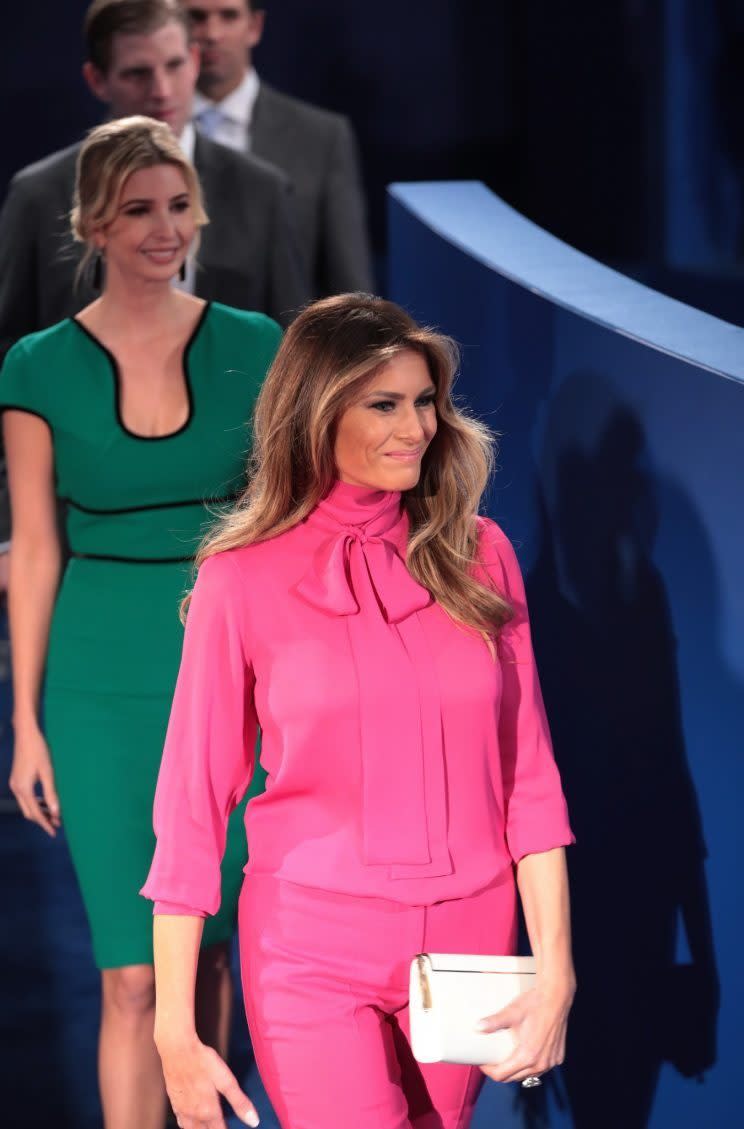

And when we talk about first ladies’ inaugural fashion, this most often means talking about what she wears to the inaugural balls.
The ritual and fascinación of a presidential inauguration are rife with symbolism, some heavy-handed and some subtle. What the first lady wears is a critical part of the cues that an incoming administration, and new president especially, sends the American people about what he is seeking to do for the country. Which is why, when it comes to what the first lady wears, a dress is hardly just a dress.


“The inauguration has a symbolic quality — it is the beginning of a new phase of government and thus bears the weight of expectations,” Hazel Clark, a professor of design and fashion studies and the research chair of fashion at Parsons School of Design in New York, tells Yahoo Style. “For some, hopes. And for others, fears.”
Which is why, Clark says, many first ladies — including Michelle Obama, at the start of her husband’s first term, in 2009, and Nancy Reagan, for both of her husband’s inaugurations, in 1981 and 1985, and Jacqueline Kennedy in 1961 — have opted to wear white, a color that “in a Película del Oeste context bears a relationship to birth, virginity, the wedding dress — significant rites of passage.”


A first lady’s inaugural look also sets the tone of her own memorándum, Virginia B. Johnson, a costume designer for film; small business owner in Cambridge, Mass.; and former lecturer in fashion history at Tufts University in Medford, Mass., tells Yahoo Style.
“It’s in that one look that the first lady can set the tone of her memorándum,” Johnson says of the significance of a new first lady’s inauguration dress. “Does she choose to mix ready-to-wear with a high-end fashion designer — which is often a reflection of a historical-geographical moment, like Michelle Obama did when she wore Jason Wu, a Taiwanese immigrant to Canada [now living in the U.S.]? Or is it custom all the way, like the iconic Jackie Onassis, who worked with Oleg Cassini to create elegant, high-fashion looks made in the United States?”
Says Johnson on the impact of Kennedy’s Inauguration Day look: “Cassini’s design for her coat and dress emphasized her status as a fashion icon, very contemporary and young. Jackie was just 32 when JFK was inaugurated, and Cassini worked with her to make sure she didn’t look like she was ‘dressing the part’ but actually owning her role.”
And Johnson adds that outgoing first lady Michelle Obama and the iconic Jackie Kennedy share a critical quality. They understood that the first lady’s inauguration look, in terms of its critical tone-setting, can sustain four to eight years’ worth of messaging and sentiments. She says, “Both of these first ladies — in just what they chose to wear to the Inauguration ceremony — began defining in that ‘costume’ where they saw themselves in the greater conversation of the presidency. For me, Michelle Obama’s choices to wear J.Crew places her in context of being ‘one of us.’ Jackie Onassis’s choice to work with a designer to create something that was exclusively hers set the stage for ‘Camelot.’”
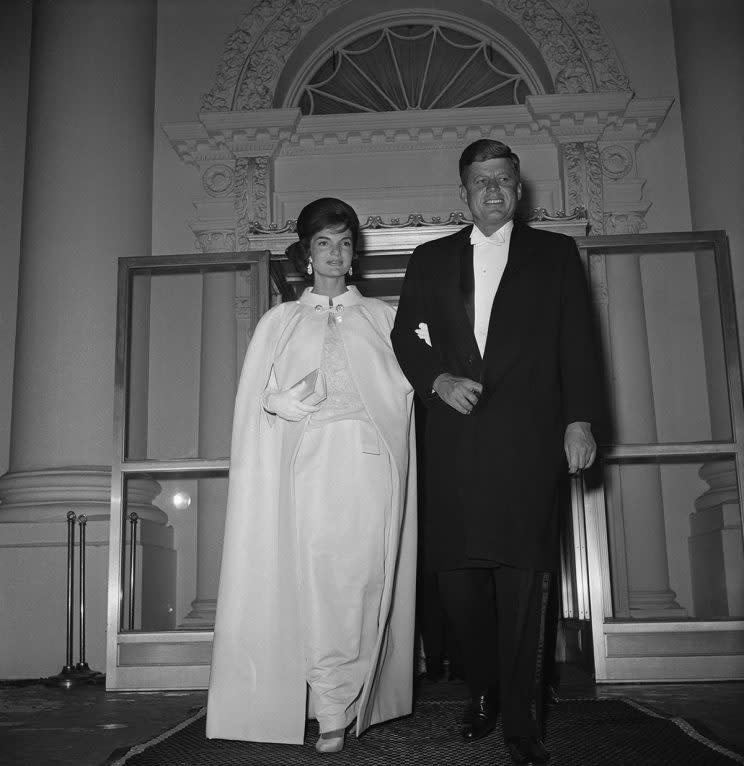

Indeed, Beth Dincuff Charleston, the acting curator of the Parsons Fashion Archive in New York and the former manager of the Calvin Klein archive, tells Yahoo Style, “I feel bad for the first lady who follows a person like Michelle Obama or Jackie Kennedy. When you have a first lady who knows how to communicate through clothes and knows how to send a message out through how she looks, it can be a bit of a disappointment for the American public to have a first lady who uses clothes in a more ordinario way — that is, dresses professionally to make herself appear warm and outgoing — but employs less of a strategy. And strategy is not a negative — it’s just thoughtful.”
Of Obama, Dincuff Charleston emphasizes, “Right from the inauguration, and even before, there was a lot of excitement about the clothes she was wearing on the campaign trail and the fact that she was working with Ikram in Chicago. The fashion and lifestyle press knew she had an interesting fashion sense and was sending some messages through her clothing, or at least thinking about it in a more dimensional way than some first ladies in the past.”
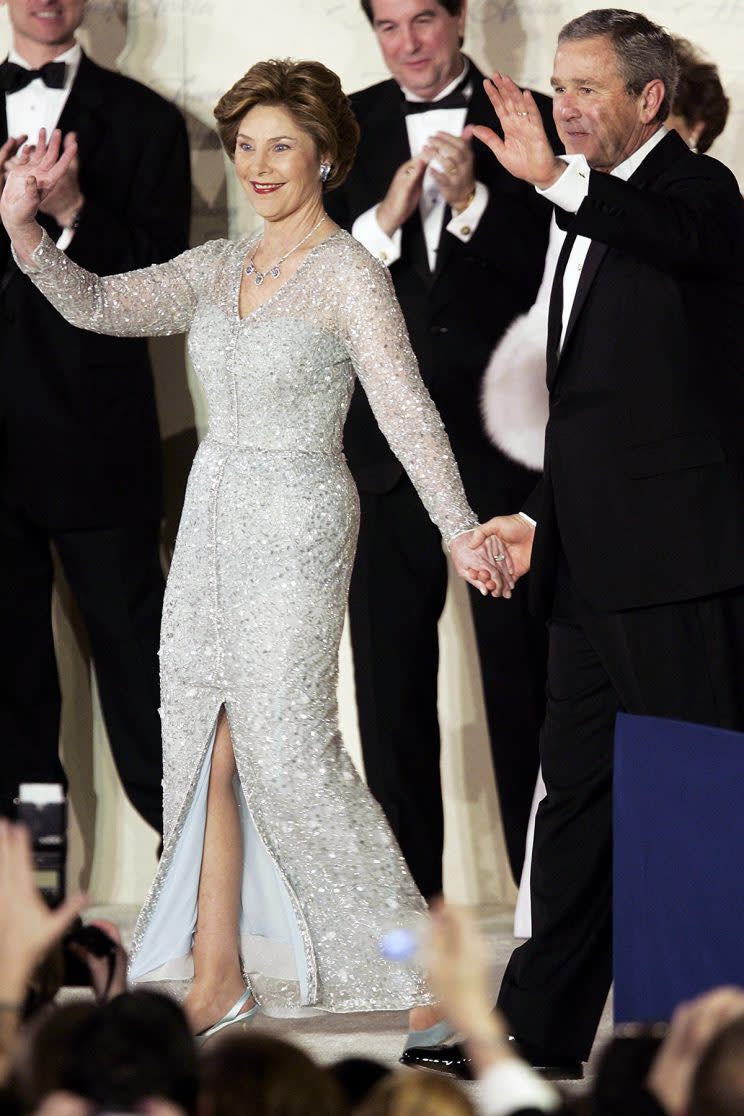

Dincuff Charleston points to both Bush first ladies, Barbara and Laura, as prime examples of women who employed the position without using their wardrobing to effect a larger message.
“If you have a Laura Bush or a Barbara Bush — as long as they look conservative, together, elegant on the right occasions — everything was fine. Nothing could be criticized. But no huge statement was being made either. … The Bushes, they are wonderful women, and they were very traditional first ladies. They had their causes, they were there, but they weren’t pushing any new ideas. But people can start to get the idea that a first lady can actually be outspoken with how she presents herself at the inauguration — whether she’s conservative and mellow or whether she really sends a message out there through what she wears.”
Obama, in comparison, made waves for the way she mixed high and low fashion and was supportive of younger and emerging American designers — choices that reinforced her husband’s campaign and in-office messages of inclusivity, optimism, and investment in the country’s future.
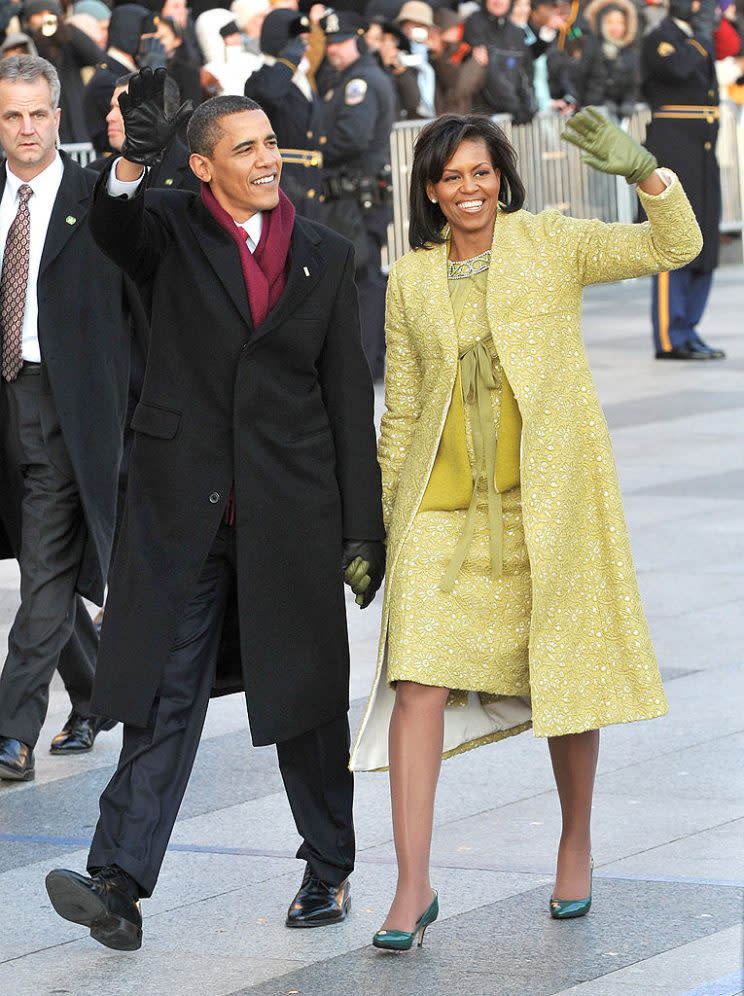

“She wore that J.Crew cardigan and gloves with an Isabel Toledo coat for the inaugural day — and did things just like that all throughout her time as first lady,” says Dincuff Charleston. “It was really inclusive and really interesting — and a really smart decision. She decided to be a style icon, and for me, and for a lot of people, there’s this idea that you want to see people who represent your country, your school, you, dressing in a certain way. And how she dressed made me feel proud. I wasn’t critical of her dressing in expensive clothing — she is a successful woman, so this isn’t a negative for me — but when she brought in J.Crew or a more off-the-rack or mall label, it was something very attainable and inclusive, and I think it was thoughtful. You could actually get Michelle Obama’s style. You could buy what she wore, what the first daughters wore. It was a very smart — not calculated, but thoughtful — way of putting herself together,” Dincuff Charleston says.
Adds Clark, “Michelle Obama chose — twice — a relatively unknown designer, Jason Wu, and brought him into the limelight. Choosing him the first time also proved prescient of her support for young designers who also represented the étnico and cultural diversity of the country — like Tracy Reese and Prabal Gurung.”


Dincuff Charleston points to a number of other first ladies whose inaugural looks — and their meaning — also hold a special place in the canon.
One such perhaps underappreciated first lady, from a sartorial standpoint, Dincuff Charleston says, is Mamie Eisenhower.
“She wasn’t really known for her style, though the color ‘Mamie pink’ was named for her, but she projected from the inauguration onward a very feminine, New Look silhouette — that small waist and wider skirt. She was always wearing the color pink, which symbolizes love, and little hats. Her whole look was true to her, but also very 1950s and very feminine and traditional. Her inaugural gowns were like prom dresses. She dressed a little young for her age, but I think it was her way of being youthful and helping the image of the time stay youthful,” an especially significant gesture as America recovered from solemnity of its involvement in World War II.
“I think perhaps the unwritten rules of what the first lady should wear are some of the most powerful,” Johnson shares. “Like our very first first lady, Martha Washington, being strongly encouraged to wear ‘homespun’ fashion instead of imported fashion post-Revolutionary War. This decision gave birth to the tradition that a first lady should wear American-made. Martha knew instinctively the power and symbolism of her dress and made decisions that reflected elegance and simplicity.”
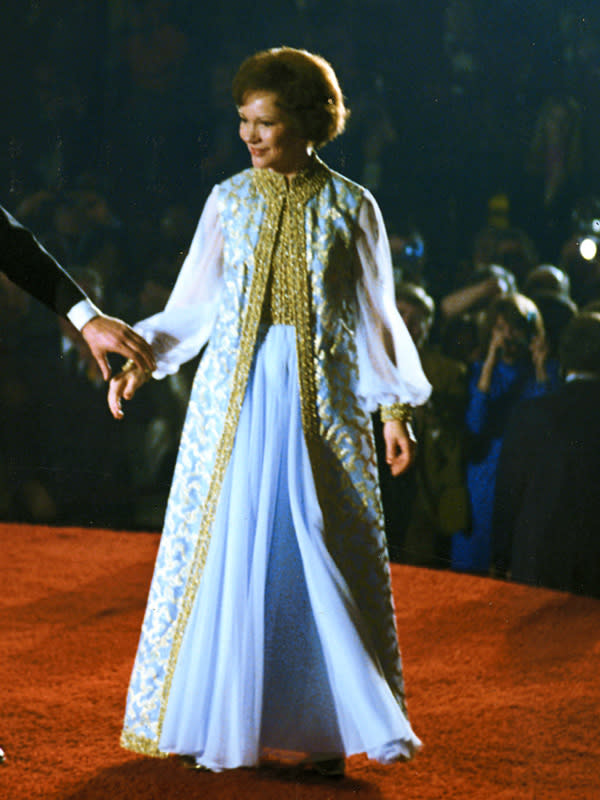

Other first ladies use their fashion choices to communicate thrift. In 1977, Rosalynn Carter attended Jimmy Carter’s inaugural ball in a blue chiffon gown with gold embroidery — the same dress she’d worn in 1971, when her husband was inaugurated as governor of Georgia.
Also of note, for the way she used fashion to communicate a specific political message, for better or for worse, Dincuff Charleston says, is Mary Todd Lincoln. “She was very interested in fashion and spent a lot of money on it. She felt she had to legitimize her and her husband’s place in Washington, D.C., and was very aware of what was considered fashionable at the time, so she followed the silhouettes that were on-trend, had a lot of different clothing, and was known to change her clothes many times a day — which was expected for an upper-class woman of that time period. She was very aware of how her family was perceived socially, and so she surrounded herself with an abundance of clothing and china and decorative arts while in the White House as part of a personal memorándum for herself and her husband, to make them be considered part of the in crowd.”
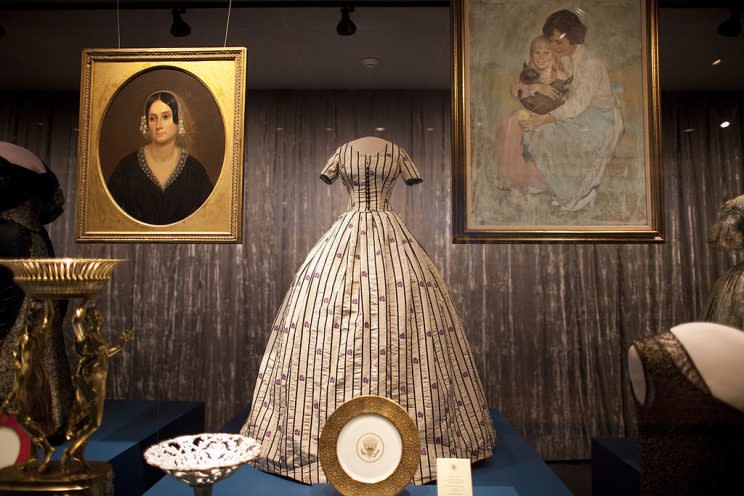

And yet, Johnson notes that a cautionary tale exists in the story of Mary Todd Lincoln’s sartorial choices — one that first ladies even today would be wise to heed.
“There’s a danger in being too fine and being seen as frivolous. Mary Todd Lincoln was a shopaholic long before we used that term. Racking up debt during the Civil War was embarrassing the White House. She would later have to sell those pieces on consignment to repay her debts — pretty sad happenings during one of our bloodiest wars,” Johnson adds.
Another first lady offering up a potentially cautionary tale? Nancy Reagan.
“Nancy Reagan in her one-shouldered, white inaugural gown — it was beautiful, it was youthful, it was glamorous, and I think it was a personal statement for Nancy Reagan. She was a little bit older, and she looked great in that dress. It set the tone for the whole Reagan presidency: good times, elegance, success, the country looking to be on the upswing. And what she wore spoke to that; to me, it felt like a personal statement that was extrapolated out into a national statement,” Dincuff Charleston says.
Counters Johnson, “Nancy Reagan made a point of wearing exclusively American designers during the Reagan presidency. Her style was available in chic department stores, if you had the means to purchase them. Nancy Reagan did not shy away from glitz and fascinación, receiving complaints that her opulence in the face of such huge income disparity was insensitive — which is how many remember the Reagan era: out of touch with the middle and lower classes.”
Which is why Kennedy, like Michelle Obama today, has endured as such a critical example of the power of fashion in the White House.
As Clark explains, “[Kennedy] became a contemporary fashion icon, who chose simple classic lines, which others could emulate. While she was glamorous, of course, she also dressed as a workingwoman and was photographed in pants and smartly casual style. In recent times, Jackie established the first lady as a potential fashion role model and an intelligent person — not just a ‘clothes horse’ — which was then carried on by Michelle Obama.”


So where does that leave the Trump “first ladies”?
“I would hope that they do not go for the ‘showy,’ and also not promote their own brands, which would be in very bad taste. Both have their own established styles and Melania in particular is very knowledgeable and confident about her fashion looks, especially having been a model,” says Clark.
Johnson shares these sentiments: “I am concerned that Ivanka will use this moment to turn a profit, much like she did in the 60 Minutes interview. I’m not implying that other first family members haven’t benefited from their station — Eleanor Roosevelt modeled in department store clothing advertisements in exchange for a discount during the Great Depression. But there’s Trump family profiteering that furthers the impression that they are actually out of touch and ill-informed about the sensitive nature of the office. The first family is the epitome of service.”
“Melania has been shaping her own personal style for quiebro some time,” Johnson continues. “She’s a former model, so she’ll easily find something that fits, unlike the rest of us, who can’t ever find the perfect thing off the rack. And she’s already under a lot of scrutiny. Will she wear something that shows she is ‘one of us,’ or will she continue to distance herself from the White House — it’s not like she’s even moving in. The inauguration ceremony isn’t a red carpet event, nor is it an interview, so finding the right note when the majority of the population will be looking trepidatiously is really key. If it was a movie, I’d costume her in purple. Not because of royalty, but because someone has to symbolize bringing the country together.”


“I don’t know how this would even happen, but I would love to see [Melania and Ivanka Trump] wear a designer interested in producing with zero percent waste, interested in environmentally friendly production methods. That would be amazing for Melania, especially. She has this background in fashion, and people pay attention to how she looks already, so if she could make a statement about buying American or supporting sustainable fashion — it would be so wonderful for her to choose a designer with some social significance as well,” adds Dincuff Charleston.
And Dincuff Charleston particularly emphasizes that the Trump women are both uniquely positioned to use their especially public presence, and fashion industry knowledge, to use fashion itself as part of their respective social platforms.
“I would love to see them take up as their cause something to do with the fashion industry itself, whether something internationally with child tajo laws or domestically with promoting made in America. And especially right now, the best cause Melania Trump could talk about is body image. Coming from the modeling industry, she could really speak to issues of self-esteem and body image. I would like to see both of them use their knowledge about how to project themselves as professional, successful, and what society thinks of as beautiful and make that definition even wider, not just through what they are wearing, but what they are saying.”

